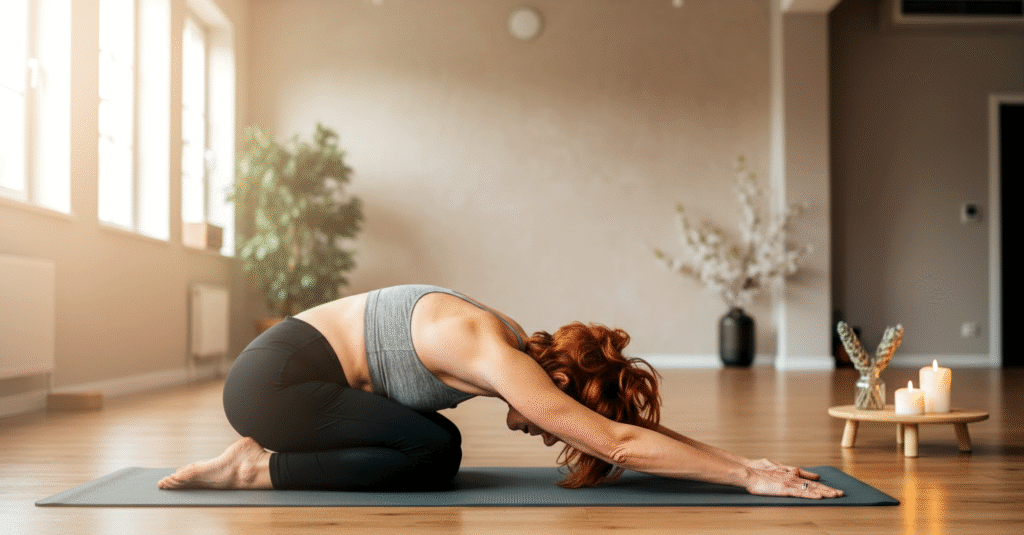Why Beginner-Friendly Yoga Matters
Starting something new can feel downright intimidating—like learning to salsa dance in the middle of a wedding when you’ve only mastered the “two-step shuffle.” For many beginners, yoga falls into this category: it looks elegant, everyone else seems flexible, and you may be secretly wondering if your hamstrings are plotting against you.
Here’s the truth: you don’t need to be flexible, young, or even remotely “zen” to begin yoga. In fact, yoga is designed to meet you where you are. And if where you are involves sitting in front of a computer, shoulders hunched and lower back protesting—well, yoga has your back (literally).
In this guide, you’ll learn:
- What beginner-friendly yoga actually looks like.
- Step-by-step routines designed for different goals (relaxation, energy, strength, flexibility).
- What to expect, pitfalls to avoid, and how to adapt poses safely.
- FAQs that answer the questions you might feel too shy to ask in class.
By the end, you’ll know exactly how to begin a simple practice at home with zero overwhelm—and maybe even enjoy the process.
What Is Beginner-Friendly Yoga?
Think of beginner-friendly yoga as the training wheels version of the practice. No complicated inversions, no human pretzel impersonations. Instead, it focuses on:
- Accessible postures: Basic poses like Mountain, Cat-Cow, and Child’s Pose rather than intimidating poses like Scorpion or full Lotus.
- Gentle pacing: Short routines (10–30 minutes) that gradually build familiarity.
- Breath awareness: Learning how to coordinate movement and breath for calm focus.
- Body respect: Modifications that make poses fit your body instead of forcing your body into a pose.
In short: beginner yoga is not about performance, it’s about building confidence and consistency.
Why Should Beginners Start Yoga?
You might be thinking, “Okay, but what does yoga really do for me beyond looking peaceful in Instagram squares?” Let’s break down the benefits that beginners notice most quickly.
1. Physical Benefits
- Improved flexibility (goodbye stiff morning stretch noises).
- Increased strength (yes, holding Downward Dog counts!).
- Better posture, as yoga strengthens the spine-supporting muscles.
- Relief from desk-job aches, especially in the lower back, neck, and shoulders.
2. Mental Benefits
- Stress relief through mindfulness and steady breathing.
- Mood enhancement thanks to a mini endorphin boost post-flow.
- Improved sleep by calming the nervous system.
3. Practical Benefits
- No fancy equipment required: just comfy clothes and (ideally) a yoga mat.
- Can be done anywhere: living room, hotel room, or even a park.
- Scales with your goals: same routine can stay gentle or increase intensity over time.
What Do I Need Before Beginning Yoga at Home?
Spoiler: you don’t need candlelit rooms, expensive mats, or crystal sound bowls (unless you want them). The basics are enough.
Must-Haves
- Comfortable clothing: Anything that allows easy movement (leggings, shorts, t-shirt).
- Yoga mat: Prevents slipping and adds cushioning for joints.
Nice-To-Haves
- Yoga blocks or books: Help modify poses for better alignment.
- Yoga strap or belt: Useful when hamstrings are tight.
- Water bottle: Hydration is your friend.
Pro Tip:
If you don’t have a mat, practice on carpet or a folded blanket. Just avoid hard, slippery floors. Your knees will thank you.
What’s the Best Way to Warm Up for Beginner Yoga?
Jumping into yoga without warming up is like pouring cold syrup on pancakes: it works, but the experience isn’t nearly as smooth.
Simple Yoga Warm-Up (5 Minutes)
- Seated Neck Rolls – Gently circle the neck to release tension.
- Shoulder Shrugs and Rolls – Forward and backward motions.
- Cat-Cow Stretch – Alternating spine arch and round movements.
- Seated Forward Fold – Light hamstring opener.
- Gentle Twists – Loosen spine and core.
This primes your body for safer, more enjoyable poses.
Which Are the Best Beginner Yoga Routines?
Ready for the main course? Below are four simple, themed routines you can rotate depending on your mood or goals. Each takes about 15–25 minutes.
Beginner Yoga Routine for Relaxation
Purpose: Calm the mind and release tension after a long day.
Steps:
- Child’s Pose (Balasana) – 1 minute.
- Cat-Cow Stretch – 5 rounds.
- Seated Forward Fold (Paschimottanasana) – 1 minute.
- Supine Spinal Twist – 1 minute each side.
- Legs Up the Wall (Viparita Karani) – 3–5 minutes.
Tip: Focus on long exhales to activate the relaxation response.
Beginner Yoga Routine for Energy Boost
Purpose: Wake up your body in the morning (more effective than scrolling social feeds in bed).
Steps:
- Mountain Pose (Tadasana) – Stand tall, ground feet.
- Half Sun Salutations – 3–5 repetitions.
- Crescent Lunge (Anjaneyasana) – 30 seconds each side.
- Warrior II (Virabhadrasana II) – 30 seconds each side.
- Standing Forward Fold (Uttanasana) – 1 minute.
Tip: Keep breath synchronized; inhale to lengthen spine, exhale to deepen poses.
Beginner Yoga Routine for Strength
Purpose: Build a resilient body—transferable strength, not beach muscles.
Steps:
- Plank Pose – 20–30 seconds.
- Chair Pose (Utkatasana) – 30 seconds.
- Downward Dog (Adho Mukha Svanasana) – 1 minute.
- Bridge Pose (Setu Bandhasana) – 30 seconds.
- Boat Pose (Navasana) – 20–30 seconds.
Tip: Start with shorter holds, gradually lengthen as strength improves.
Beginner Yoga Routine for Flexibility
Purpose: Free hips and hamstrings that have been sitting too long in office chairs.
Steps:
- Low Lunge (Anjaneyasana) – 30 seconds each side.
- Butterfly Stretch (Baddha Konasana) – 1–2 minutes.
- Seated Wide-Angle Forward Fold – 1–2 minutes.
- Cow Face Pose (Ardha Gomukhasana) – 30 seconds each side.
- Happy Baby Pose (Ananda Balasana) – 1–2 minutes.
Tip: Never force deeper; let muscles release gradually through the breath.
Comparison Table: Which Routine Should You Pick?
| Goal | Best Routine | Time Needed | Main Benefits | Best Time to Practice |
|---|---|---|---|---|
| Relaxation | Relaxing Flow | 15 mins | Stress relief, better sleep | Evening or before bed |
| Energy | Energizing Flow | 20 mins | Alertness, circulation, focus | Morning or midday slump |
| Strength | Strength Flow | 20–25 mins | Core stability, endurance, posture | Morning or afternoon |
| Flexibility | Flexibility Flow | 20 mins | Hip/hamstring mobility, body openness | After workout or long work day |
How Often Should Beginners Practice Yoga?
Here’s the “official but friendly” answer:
- 2–3 times per week is enough to notice benefits.
- Even 10 minutes daily can build habit and comfort.
- Consistency matters more than intensity.
Think of yoga like brushing your teeth—you don’t need a marathon session, just regular upkeep.
How Do I Stay Motivated as a Beginner?
- Set tiny goals: 10 minutes today, 15 minutes next week.
- Create a ritual: Same space, same time, maybe a candle or playlist.
- Track progress: Notice posture improvements, reduced stiffness, calmer mind.
- Celebrate consistency, not perfection: Missing a pose is fine; missing the habit is what matters.
FAQs: Beginner-Friendly Yoga
1. Can I do yoga if I’m not flexible?
Absolutely. Flexibility is a result of yoga, not a requirement. Beginners often find yoga helps reduce stiffness over just a few weeks.
2. Is yoga enough for exercise?
For many, yes—it builds strength, flexibility, and endurance. But if weight loss or cardiovascular health is a goal, yoga can combine beautifully with walking, cycling, or swimming.
3. What’s the best time of day to do yoga?
Anytime that fits your lifestyle. Morning flows boost energy, while evening sessions help with relaxation and better sleep.
4. Should beginners join a class or practice at home?
Both work. Online videos and apps make home practice easy. In-person classes offer guidance, feedback, and accountability. A mix is ideal.
5. Can yoga help with stress and anxiety?
Yes. Studies show yoga lowers cortisol (the stress hormone) and promotes calm through mindful breathing. Even 10 minutes can shift mood.
6. What if a pose feels uncomfortable?
Modify, use props, or skip it. Yoga is about awareness, not pain tolerance. Discomfort signals growth, but pain signals “stop.”
Final Thoughts: Starting Small Creates Big Change
Yoga isn’t about being perfect—it’s about showing up, moving with intention, and noticing how your body feels today, not comparing it to yesterday or Instagram influencers. Starting with beginner-friendly yoga routines makes the practice accessible, sustainable, and, most importantly, enjoyable.
Choose one of the routines above this week, set aside 15 minutes, and see how you feel. Over time, you’ll notice your strength, flexibility, and calm grow—not from forcing progress, but from gently, consistently showing up.
If this guide helped you, share it with a friend who’s been curious about yoga. Maybe you’ll both discover just how much space yoga can carve out for well-being in daily life.

